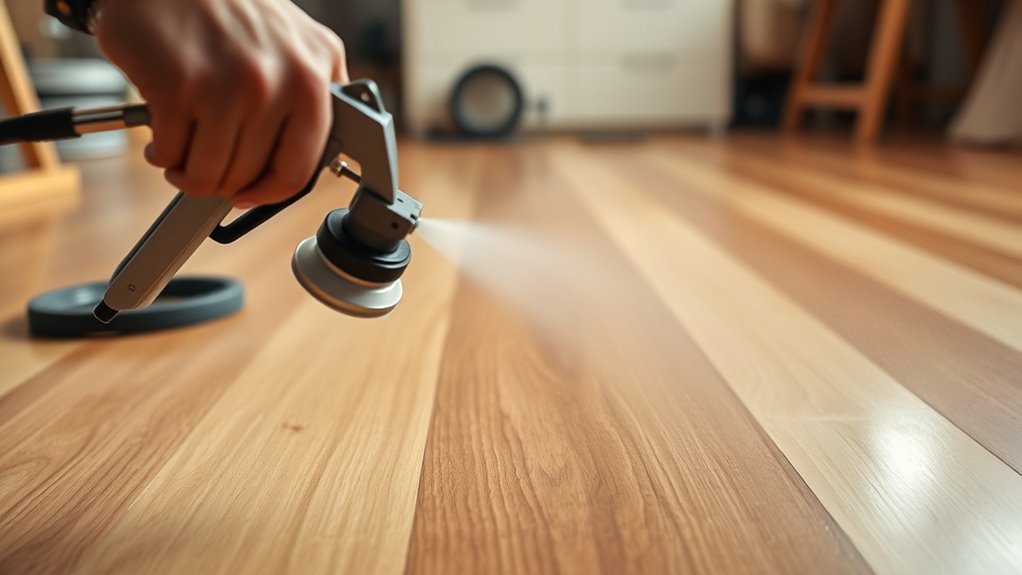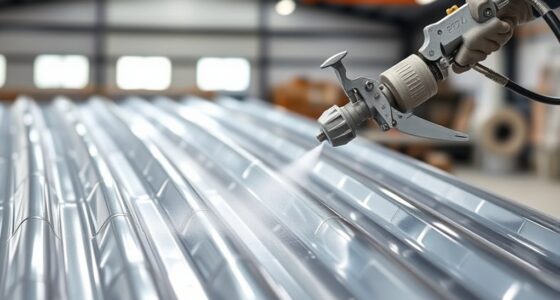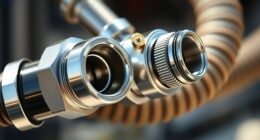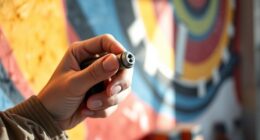To spray floors with polyurethane without bubbles, keep your sprayer clean and properly thinned according to instructions. Maintain a steady, smooth motion and keep the spray about 6 to 12 inches from the surface, overlapping each pass by 50%. Use light, even coats and allow each layer to dry thoroughly before applying the next. Paying attention to technique and equipment care guarantees a flawless finish—if you want detailed tips, you’ll find them here.
Key Takeaways
- Thin polyurethane properly according to manufacturer’s instructions to ensure smooth atomization and reduce bubble formation.
- Maintain a consistent spray distance of 6 to 12 inches from the surface for even coverage.
- Use light, overlapping coats with steady, smooth movements to prevent buildup and air entrapment.
- Regularly clean the spray gun, nozzle, and tip during and after use to avoid clogs and bubbles.
- Allow each coat to dry completely before applying the next to prevent trapping air and bubbles.

Spraying polyurethane on floors is an efficient way to achieve a smooth, durable finish. To do this successfully, you need to master the right techniques and keep your equipment in top shape. One key aspect is understanding your spray gun and how to apply the polyurethane evenly. While brushing can sometimes be used for touch-ups, spraying provides a more consistent coat, especially over large surfaces. Before you start, practice your brush techniques on a scrap piece to get a feel for the flow and coverage. This way, you’ll develop a steady hand and minimize the risk of drips or uneven layers. When it comes to spraying, your goal is to maintain a consistent distance from the floor—usually about 6 to 12 inches—and keep the spray gun moving smoothly across the surface. This helps prevent buildup or thin spots, both of which can cause bubbles or an uneven finish.
Sprayer maintenance plays an essential role in achieving a bubble-free coat. Before you begin, thoroughly clean your sprayer to remove any old paint or debris that could clog the nozzle. A clogged nozzle may cause inconsistent spray patterns, leading to surface imperfections like bubbles or uneven texture. Regularly check the spray tip for any buildup and clear it as needed. Keep the paint mixture properly thinned according to the manufacturer’s instructions, as thick paint is more prone to atomization problems that create bubbles. During spraying, avoid rushing—apply the polyurethane in light, even coats, and let each layer dry completely before adding the next. Overlapping your passes by about 50% ensures even coverage and minimizes thin spots that might trap air or bubbles. Using the appropriate spray technique will further help prevent issues such as bubbles and uneven finishes.
Additionally, maintaining proper spray technique helps prevent bubbles from forming. Keep your wrist loose and avoid tilting the spray gun excessively. Moving at a steady pace and applying gentle, overlapping strokes reduces the chance of introducing air into the finish. If you notice bubbles forming during spraying, stop and inspect your equipment, adjusting the pressure or cleaning the nozzle if needed. After finishing, clean your sprayer thoroughly to prevent dried polyurethane from clogging the nozzle in future projects. Proper maintenance not only guarantees a bubble-free finish but also prolongs the life of your sprayer. In conclusion, combining good brush techniques for touch-ups, careful sprayer maintenance, and consistent application speed will help you achieve a flawless, bubble-free polyurethane floor finish.
Frequently Asked Questions
Can I Spray Polyurethane Outdoors Safely?
Yes, you can spray polyurethane outdoors safely if you take proper precautions. Make certain good outdoor safety by spraying on a calm, dry day to prevent dust and debris from settling. Be mindful of environmental concerns by using low-VOC or eco-friendly polyurethane options. Wear protective gear, like masks and goggles, to avoid inhaling fumes. Properly dispose of any leftover materials to protect the environment and maintain safety.
What Type of Spray Equipment Is Best for Floors?
For spraying floors with polyurethane, you should choose a high-quality HVLP sprayer or airless sprayer. These options provide even coverage and reduce bubbles when used correctly. Focus on spray equipment selection based on your project size and detail needs. Proper maintenance, like cleaning the nozzle and filters after each use, guarantees consistent flow and prevents clogging. This keeps your spray equipment working efficiently and gives you a smooth, bubble-free finish.
How Long Should I Wait Between Coats?
You should wait at least 4 to 6 hours between coats, but always verify the drying time on your polyurethane’s label, as it can vary. Don’t rush the recoat interval; patience ensures a smooth finish free of bubbles. If you’re unsure, wait a bit longer—better safe than risking imperfections. Proper drying time guarantees your layers adhere well, giving your floor a durable, flawless look.
Is It Necessary to Sand Between Polyurethane Coats?
Yes, sanding between polyurethane coats is necessary. You should perform light sanding for proper sanding preparation, which helps smooth the surface and remove any imperfections. This step also guarantees better coat adhesion, preventing bubbles and peeling later on. Use a fine-grit sandpaper and gently sand the previous layer. Afterward, wipe away dust thoroughly before applying the next coat to achieve a professional, bubble-free finish.
How Do Temperature and Humidity Affect Spraying Results?
Think of your spray project like sailing a boat; the weather—temperature and humidity—dictates your journey. If it’s too humid, moisture control becomes tricky, causing bubbles or uneven finishes. Too cold or hot, and the polyurethane may not dry properly. Maintain steady temperature regulation and keep humidity low to make certain of smooth spraying results. Adjust your environment, and you’ll navigate your project with ease, achieving a flawless, bubble-free finish.
Conclusion
Now that you know how to spray floors with polyurethane without bubbles, you’re ready to achieve a smooth, professional finish. Remember, patience and proper technique really make a difference—think of it as a dance where each step counts. If you keep the spray consistent and avoid rushing, you’ll see that the bubbles disappear just like they never existed. Trust the process, stay steady, and enjoy your beautifully coated floors that look flawless and durable.
Franz came aboard the Paint Sprayer Zone team with a background in both journalism and home renovation. His articulate writing style, combined with a passion for DIY projects, makes him an invaluable asset. Franz has a knack for breaking down technical jargon into easy-to-understand content, ensuring that even the most novice of readers can grasp the complexities of paint sprayers.










